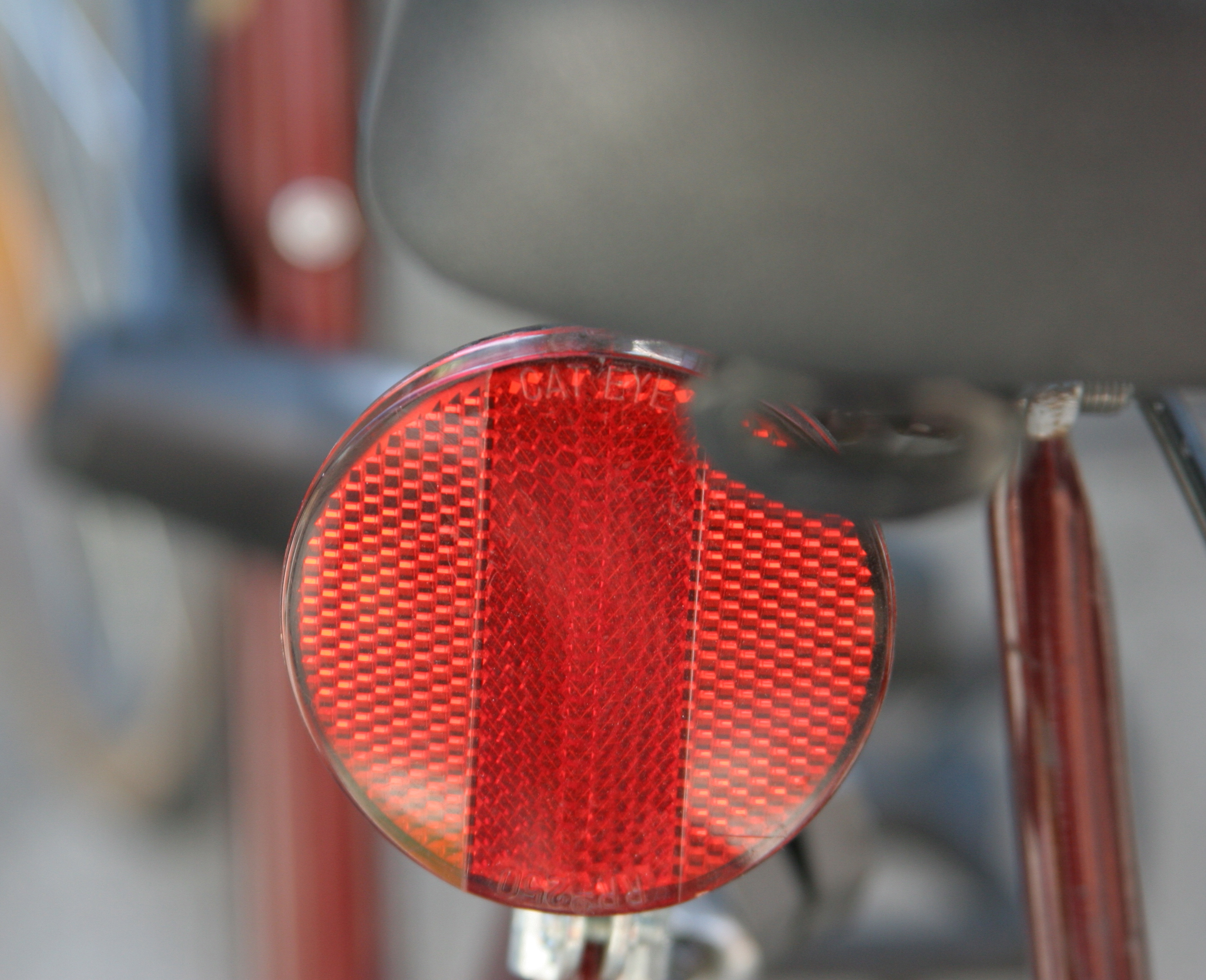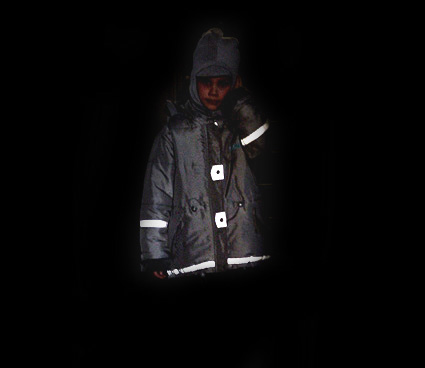Safety reflector on:
[Wikipedia]
[Google]
[Amazon]

 A safety reflector is a
A safety reflector is a
 Within the European Union, safety reflectors for pedestrians must be certified to comply with the CE EN 13356 safety standard. This standard is specifically for "loose, reflective accessories for personal use". There are other standards for other types of reflectors such as safety vests and reflectors on bicycles.
In Finland, Estonia, Latvia and Lithuania, pedestrians are required by law to wear safety reflectors when walking during dark conditions.
Within the European Union, safety reflectors for pedestrians must be certified to comply with the CE EN 13356 safety standard. This standard is specifically for "loose, reflective accessories for personal use". There are other standards for other types of reflectors such as safety vests and reflectors on bicycles.
In Finland, Estonia, Latvia and Lithuania, pedestrians are required by law to wear safety reflectors when walking during dark conditions.
File:Corner-reflector.svg, alt=Corner reflector.svg, The Corner Reflector reflects light back towards the source.
File:Headlights projector reflector optics.jpg, Car reflector (in the lower part of the bumper)
File:Turvaheijastin.jpg, Star-shaped safety reflector with string and safety pin
Driving simulator that highlights the benefits of safety reflectors (Finnish Road Safety Council)
{{DEFAULTSORT:Safety Reflector Vehicle parts Fashion accessories Reflector Finnish inventions

retroreflector
A retroreflector (sometimes called a retroflector or cataphote) is a device or surface that reflects radiation (usually light) back to its source with minimum scattering. This works at a wide range of angle of incidence, unlike a planar mirror, ...
intended for pedestrian
A pedestrian is a person traveling on foot, whether walking or running. In modern times, the term usually refers to someone walking on a road or pavement, but this was not the case historically.
The meaning of pedestrian is displayed with ...
s, runners, motorized and non-motorized vehicle
A vehicle (from la, vehiculum) is a machine that transports people or cargo. Vehicles include wagons, bicycles, motor vehicles (motorcycles, cars, trucks, buses, mobility scooters for disabled people), railed vehicles (trains, trams), wa ...
s. A safety reflector is similar to reflective stripes that can be found on safety vests and clothing worn by road workers and rescue workers. They are sometimes erroneously called luminous badges or luminous tags, but this is incorrect as they do not themselves produce light, but only reflect it.
A safety reflector aids visibility of a person or vehicle visible to on the road, as it reflects light from headlight
A headlamp is a lamp (electrical component), lamp attached to the front of a vehicle to illuminate the road ahead. Headlamps are also often called headlights, but in the most precise usage (language), usage, ''headlamp'' is the term for the ...
s of vehicles. Safety reflectors are especially useful where there are no streetlight
A street light, light pole, lamp pole, lamppost, street lamp, light standard, or lamp standard is a raised source of light on the edge of a road or path. Similar lights may be found on a railway platform. When urban electric power distribution ...
s.
Unlike reflective stripes that are permanently fixed to clothing, the safety reflector is a stand-alone device that can be attached to any article of clothing
Clothing (also known as clothes, apparel, and attire) are items worn on the body. Typically, clothing is made of fabrics or textiles, but over time it has included garments made from animal skin and other thin sheets of materials and natural ...
as needed, often using a safety pin
The safety pin is a variation of the regular pin which includes a simple spring mechanism and a clasp. The clasp forms a closed loop to properly fasten the pin to whatever it is applied to and covers the end of the pin to protect the user from th ...
and some string. For vehicles, the reflector is usually a fixed part. In bicycles, reflectors are usually on wheels, pedals, under the seat, on the back of the luggage rack, and in front of the front fork. In motorcycles, automobiles, and other vehicles, reflectors are built into the front and rear ends (and sides) next to the headlights and brake lights.
Issue
Fatal traffic accidents at night often involve vehicles with drivers who fail to see pedestrians or bicyclists until they are too close to avoid collision. Reflectors are expected to increase visibility and contribute to safety.History
The reflector was first invented en 1917 in Nice by Henri Chrétien to provide the army a communication system the enemy could not intercept. Patent is labelled ''cataphote'' in 1923. The ''cataphote'' was also invented by Garbarini by combining a convex lens and concave mirror. It was used for aviation, safety in Switzerland and advertising in France. On 12 march 1925, the minister, the ''Réseau du Nord'' railway company and the ''Touring-Club de France'' experienced the use of ''cataphotes'' to make level crossings visible by night. In 1926, an automobile club, the ''Touring-Club de France'', offered 180 signals with triangular ''cataphote'' to warn for the presence of the level crossings. In 1927, fines were given in France to car owners which did not have the ''cataphote'' made mandatory by law. The same year, ''cataphote'' were sold for motorized vehicles, motorbikes, bicycles and any kind of trailers. In 1946, French regulation for ''catadioptre'' was NF R 143 11. On first January 1950, safety ''catadioptre'' were made mandatory on the rear side of French vehicles. In January 1943, a US highway patrolman Raymond Trask proposed the concept of the single ''cataphote'' for pedestrians to help them be visible for drivers in aPopular Science
''Popular Science'' (also known as ''PopSci'') is an American digital magazine carrying popular science content, which refers to articles for the general reader on science and technology subjects. ''Popular Science'' has won over 58 awards, incl ...
publication.
The reflector is a Finnish
Finnish may refer to:
* Something or someone from, or related to Finland
* Culture of Finland
* Finnish people or Finns, the primary ethnic group in Finland
* Finnish language, the national language of the Finnish people
* Finnish cuisine
See also ...
creation, invented by a farmer Mr. Arvi Lehti from Pertteli
Pertteli (); sv, S:t Bertils) is a former municipality of Finland. It was consolidated with Salo on January 1, 2009.
It is located in the province of Western Finland and is part of the Southwest Finland region. The municipality had a population ...
, a small township in Western Finland. The inventor did not consider pedestrian safety when creating the first reflectors: he simply wished to protect his horse carts and carriages. Reflectors were introduced to Finns in 1960. Nowadays one can find reflectors of all possible shapes and colours, as design and fashion industries have turned their faces towards this diminutive gadget. Special 'clip-on' reflectors for bicycles and other human-powered vehicles are also common.
On first November 1963, Unece regulation number 3 entered into force in its original version.
European regulations
Reflector for vulnerable users and non motorized vehicles
 Within the European Union, safety reflectors for pedestrians must be certified to comply with the CE EN 13356 safety standard. This standard is specifically for "loose, reflective accessories for personal use". There are other standards for other types of reflectors such as safety vests and reflectors on bicycles.
In Finland, Estonia, Latvia and Lithuania, pedestrians are required by law to wear safety reflectors when walking during dark conditions.
Within the European Union, safety reflectors for pedestrians must be certified to comply with the CE EN 13356 safety standard. This standard is specifically for "loose, reflective accessories for personal use". There are other standards for other types of reflectors such as safety vests and reflectors on bicycles.
In Finland, Estonia, Latvia and Lithuania, pedestrians are required by law to wear safety reflectors when walking during dark conditions.
Reflector for motorized vehicles
The EU use Unece regulation number 3 to categorize safety reflectors in several class: IA, IB, IIIA, IIIB and IVA. The EU use Unece regulation 104 for retro-reflective markings for vehicles of category M2 and M3 (transport of people), N (transport of good), O2 , O3 and O4 (trailers). This regulation use colored markings. The EU also has in its law the Council Directive 76/757/EEC of 27 July 1976 on the approximation of the laws of the Member States relating to reflex reflectors for motor vehicles and their trailers.Image gallery
Bicycle reflector
A bicycle reflector or prism reflector is a common safety device found on the rear, front and wheels of bicycles. It uses the principle ofretroreflection
A retroreflector (sometimes called a retroflector or cataphote) is a device or surface that reflects radiation (usually light) back to its source with minimum scattering. This works at a wide range of angle of incidence, unlike a planar mirror, ...
to alert another road user of the bicycle's presence on the road.
The reflector is usually manufactured in the form of a moulded tile of transparent plastic. The outside surface is smooth, allowing light, such as from a car's headlights, to enter. The rear surface of the tile takes the form of an array of angled micro-prisms or spherical beads.
The light striking the rear, inside surface of the prisms or beads, does so at an angle greater than the critical angle
Critical angle may refer to:
*Critical angle (optics), the angle of incidence above which total internal reflection occurs
*Critical angle of attack
In fluid dynamics, angle of attack (AOA, α, or \alpha) is the angle between a reference lin ...
thus it undergoes total internal reflection
Total internal reflection (TIR) is the optical phenomenon in which waves arriving at the interface (boundary) from one medium to another (e.g., from water to air) are not refracted into the second ("external") medium, but completely reflected b ...
. Due to the orientation of the other inside surfaces, any light internally reflecting is directed back out the front of the reflector in the direction it came from. This alerts the person close to the light source, e.g. the driver of the vehicle, to the presence of the cyclist.Complete physics, Stephen Pople 1999
See also
*High-visibility clothing
High-visibility clothing, sometimes shortened to hi vis or hi viz, is any clothing worn that is highly luminescent in its natural matt property or a color that is easily discernible from any background. It is most commonly worn on the torso and ...
References
External links
Driving simulator that highlights the benefits of safety reflectors (Finnish Road Safety Council)
{{DEFAULTSORT:Safety Reflector Vehicle parts Fashion accessories Reflector Finnish inventions